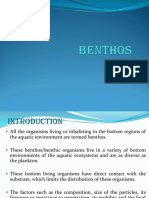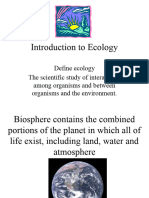Ecosystem Diversity
Ecosystem Diversity
Uploaded by
liezl ann g. valdezCopyright:
Available Formats
Ecosystem Diversity
Ecosystem Diversity
Uploaded by
liezl ann g. valdezOriginal Title
Copyright
Available Formats
Share this document
Did you find this document useful?
Is this content inappropriate?
Copyright:
Available Formats
Ecosystem Diversity
Ecosystem Diversity
Uploaded by
liezl ann g. valdezCopyright:
Available Formats
Ecosystem diversity deals with the variations in ecosystems within a geographical location and its overall
impact on human existence and the environment.
Ecosystem diversity is a type of biodiversity. It is the variation in the ecosystems found in a region or the
variation in ecosystems over the whole planet. Biodiversity is important because it clears out our water,
changes out climate, and provides us with food.Ecological diversity includes the variation in both
terrestrial and aquatic ecosystems. Ecological diversity can also take into account the variation in the
complexity of a biological community, including the number of different niches, the number of trophic
levels and other ecological processes. An example of ecological diversity on a global scale would be the
variation in ecosystems, such as deserts, forests, grasslands, wetlands and oceans. Ecological diversity is
the largest scale of biodiversity, and within each ecosystem, there is a great deal of both species and
genetic diversity.
Some examples of ecosystems that are rich in diversity are:
Deserts-A desert is a barren area of landscape where little precipitation occurs and, consequently, living
conditions are hostile for plant and animal life.
Forests-A forest is a large area dominated by trees
Large marine ecosystems-are regions of the world's oceans, encompassing coastal areas from river basins
and estuaries to the seaward boundaries of continental shelves and the outer margins of the major ocean
current systems.
Marine ecosystems-are the largest of Earth's aquatic ecosystems and are distinguished by waters that have
a high salt content.
Old growth forests-also termed primary forest or late seral forest — is a forest that has attained great age
without significant disturbance and thereby exhibits unique ecological features and might be classified as
a climax community.
Rainforests-re forests characterized by high rainfall, with annual rainfall in the case of tropical rainforests
between 250 and 450 centimetres (98 and 177 in),[1] and definitions varying by region for temperate
rainforests.
Tundra-is a type of biome where the tree growth is hindered by low temperatures and short growing
seasons. The term tundra comes through Russian тундра (tûndra) from the Kildin Sami word тӯндар
(tūndâr) meaning "uplands", "treeless mountain tract"
Coral Reefs-s an underwater ecosystem characterized by reef-building corals. Reefs are formed of
colonies of coral polyps held together by calcium carbonate. Most coral reefs are built from stony corals,
whose polyps cluster in groups.
Marine-is the scientific study of marine life, organisms in the sea.
You might also like
- Lesson Plan in Word RecognitionDocument4 pagesLesson Plan in Word Recognitionliezl ann g. valdez100% (1)
- Types of EcosystemDocument4 pagesTypes of EcosystemSuganya Aruchamy100% (3)
- Terrestrial EcosystemDocument2 pagesTerrestrial EcosystemGie Marie Francisco Umali100% (1)
- 1.5 Ecological Succession-2Document7 pages1.5 Ecological Succession-2Patrick batemenNo ratings yet
- Forest ConservationDocument33 pagesForest ConservationJay GrijaldoNo ratings yet
- Species InteractionDocument19 pagesSpecies InteractionStyrich Nyl AbayonNo ratings yet
- LeavesDocument16 pagesLeavesjasta114No ratings yet
- Understanding The EnvironmentDocument56 pagesUnderstanding The EnvironmentSsNo ratings yet
- Roots: Functions, Forms, and RegionsDocument17 pagesRoots: Functions, Forms, and RegionsJoe marie BotioNo ratings yet
- Sources-and-Variation-of-Trees 2Document10 pagesSources-and-Variation-of-Trees 2Clariss MortejoNo ratings yet
- Plant Transport To WriteDocument17 pagesPlant Transport To WritelaibahundekarNo ratings yet
- IucnDocument34 pagesIucnsaaisNo ratings yet
- Law of The Limiting FactorsDocument4 pagesLaw of The Limiting FactorsBiswajit DarbarNo ratings yet
- Boundaries of EcosystemDocument7 pagesBoundaries of EcosystemUj Umar0% (1)
- Plant Nutrient Functions and Deficiency and Toxicity SymptomsDocument16 pagesPlant Nutrient Functions and Deficiency and Toxicity SymptomsTang Tiong Min 郑中铭No ratings yet
- Assignment: Topic: Stream EcosystemDocument20 pagesAssignment: Topic: Stream EcosystemAbhija YacobNo ratings yet
- Lake Morphometry: Shape and Size of Lake InfluencesDocument5 pagesLake Morphometry: Shape and Size of Lake InfluencesReinaur Signey AluningNo ratings yet
- 6 HydrosphereDocument11 pages6 HydrosphereAndrew GravesNo ratings yet
- Ecology 4, CommunityDocument45 pagesEcology 4, CommunityAnaya ChNo ratings yet
- CBDDocument36 pagesCBDranger0No ratings yet
- Botkin7e Lecture PPT Ch10Document48 pagesBotkin7e Lecture PPT Ch10Daniel GrahamNo ratings yet
- ECOLOGY & Climatic FactorsDocument17 pagesECOLOGY & Climatic Factorsrajshgupta01No ratings yet
- Soil OrganismsDocument4 pagesSoil Organismstibau4No ratings yet
- Climate and BiodiversityDocument40 pagesClimate and BiodiversityellowcodyNo ratings yet
- Basic Concepts To BotanyDocument6 pagesBasic Concepts To BotanyPrincess De LeonNo ratings yet
- Ecological SuccessionDocument4 pagesEcological SuccessionChristine ShellyNo ratings yet
- Ben ThosDocument19 pagesBen ThosBikash KokoiNo ratings yet
- Freshwater Ecosystem Final OutlineDocument13 pagesFreshwater Ecosystem Final OutlineSereneNo ratings yet
- SYSTEMATICSDocument6 pagesSYSTEMATICSShelo Angielou Zurita100% (1)
- Global EcologyDocument5 pagesGlobal EcologyLonnie AsisNo ratings yet
- Ecosystem ProductivityDocument2 pagesEcosystem ProductivityvijendNo ratings yet
- Succession: (Climax Community)Document38 pagesSuccession: (Climax Community)KanchanNo ratings yet
- Biodiversity & Its TypesDocument9 pagesBiodiversity & Its Typesakhileshmoney73% (11)
- Unit-6, GeneticsDocument25 pagesUnit-6, GeneticsKerala MekuriyaNo ratings yet
- Cytoskeleton 2Document7 pagesCytoskeleton 2Basil Francis AlajidNo ratings yet
- Gene Pools and Mutations Ch9Document22 pagesGene Pools and Mutations Ch9bobNo ratings yet
- Plant EcologyDocument40 pagesPlant EcologyirijaamirNo ratings yet
- GENELECT2 - Lesson 4 Species Interactions, Ecological Succession, and Population ControlDocument40 pagesGENELECT2 - Lesson 4 Species Interactions, Ecological Succession, and Population ControlCamela Grace CabilaoNo ratings yet
- Aquatic ZonationDocument28 pagesAquatic ZonationAnna SkullHong ChullyHeenimNo ratings yet
- Plant TissuesDocument24 pagesPlant TissuesKen Torres Paycana100% (1)
- The History of Cells and Cell TheoryDocument12 pagesThe History of Cells and Cell TheoryannaNo ratings yet
- SUMMURIZEDocument55 pagesSUMMURIZEWaren LlorenNo ratings yet
- Natural Resources: Prepared By, Mr. Snehal Patel Assistant Professor, Sumandeep Vidyapeeth, Vadodara, Gujarat, IndiaDocument52 pagesNatural Resources: Prepared By, Mr. Snehal Patel Assistant Professor, Sumandeep Vidyapeeth, Vadodara, Gujarat, IndiaJagesh RanjanNo ratings yet
- Taxonomy 3Document18 pagesTaxonomy 3Jessa BelleNo ratings yet
- Philippines FreshwaterDocument11 pagesPhilippines FreshwaterBJ Allon Mallari100% (1)
- 6.LECTURE 6 - TaxonomyDocument35 pages6.LECTURE 6 - TaxonomyMuhammad Danial HasanNo ratings yet
- PowerPoint - Anatomy of PlantsDocument72 pagesPowerPoint - Anatomy of PlantsDeoveon Cadoree100% (1)
- Lake Morphometry: A Beginner's Guide To Water ManagementDocument39 pagesLake Morphometry: A Beginner's Guide To Water ManagementSam GregoryNo ratings yet
- Lesson 2 - Ecological Dynamics and ConceptsDocument68 pagesLesson 2 - Ecological Dynamics and ConceptsIgnacio Joshua H.No ratings yet
- Topic 8 Classifications of Horticultural CropsDocument16 pagesTopic 8 Classifications of Horticultural CropsAndre Miguel Llanes100% (1)
- Phylum NematodaDocument2 pagesPhylum NematodaMA. LYN CASIPENo ratings yet
- What Is Ecology PDFDocument113 pagesWhat Is Ecology PDFDarshan MarjadiNo ratings yet
- Ecosystem & Diversity PDFDocument23 pagesEcosystem & Diversity PDFSSr ReddyNo ratings yet
- Nomenclature: History & Basic Information of Nomenclature PlantsDocument9 pagesNomenclature: History & Basic Information of Nomenclature Plantskamran100% (1)
- Carbohydrate Metabolism of PlantsDocument40 pagesCarbohydrate Metabolism of PlantsCalvin HuangNo ratings yet
- Freshwater EcosystemDocument23 pagesFreshwater EcosystemBryanMarkSusGuetaNo ratings yet
- Lecture On Biodiversity: Introduction To Environmental ScienceDocument70 pagesLecture On Biodiversity: Introduction To Environmental ScienceJubair Syed100% (1)
- L21 Quantitative Genetics: ! !relax 2 Classical Assumptions: ! Interaction! (2) No Environmental Effects !Document36 pagesL21 Quantitative Genetics: ! !relax 2 Classical Assumptions: ! Interaction! (2) No Environmental Effects !jdazuelosNo ratings yet
- Ecological Succession PPTDocument47 pagesEcological Succession PPTLaurent FrancisNo ratings yet
- Types of Ecosystem – Ecosystem Structures & FunctionsDocument23 pagesTypes of Ecosystem – Ecosystem Structures & Functionslikekeke3No ratings yet
- New Microsoft Office Word DocumentDocument48 pagesNew Microsoft Office Word DocumentSuperpower KhilafahNo ratings yet
- Chapter 1-2-FOOD RESILIENCE OF SELECTED FAMILIES IN SOCKSARGEN AMIDST THE COVIDDocument14 pagesChapter 1-2-FOOD RESILIENCE OF SELECTED FAMILIES IN SOCKSARGEN AMIDST THE COVIDliezl ann g. valdezNo ratings yet
- Training Design INSET 2021Document4 pagesTraining Design INSET 2021liezl ann g. valdezNo ratings yet
- Work Immersion AppraisalDocument7 pagesWork Immersion Appraisalliezl ann g. valdezNo ratings yet
- Video Editing Training DesignDocument4 pagesVideo Editing Training Designliezl ann g. valdezNo ratings yet
- Modified Concept Paper Topic:: Blood Work Is A 1998 Drama Film Written On March 9, 1998 and Directed byDocument2 pagesModified Concept Paper Topic:: Blood Work Is A 1998 Drama Film Written On March 9, 1998 and Directed byliezl ann g. valdezNo ratings yet
- Work Home Learning Plan: Subject/Year Level: English 10 Quarter: First Date: October 5-9, 2020 WeekDocument7 pagesWork Home Learning Plan: Subject/Year Level: English 10 Quarter: First Date: October 5-9, 2020 Weekliezl ann g. valdezNo ratings yet
- LESSON PLAN-parallelismDocument3 pagesLESSON PLAN-parallelismliezl ann g. valdezNo ratings yet
- Wedding ScriptDocument3 pagesWedding Scriptliezl ann g. valdezNo ratings yet
- LDM Course - RoldanDocument38 pagesLDM Course - Roldanliezl ann g. valdezNo ratings yet
- Persuasive Speech About EducationDocument1 pagePersuasive Speech About Educationliezl ann g. valdez100% (4)
- Liezl Ann G. Valdez: ObjectiveDocument2 pagesLiezl Ann G. Valdez: Objectiveliezl ann g. valdezNo ratings yet
- APAformat UnfinishedDocument10 pagesAPAformat Unfinishedliezl ann g. valdezNo ratings yet
- Van Vat: Name: - GradeDocument1 pageVan Vat: Name: - Gradeliezl ann g. valdezNo ratings yet
- Review of Related LiteratureDocument5 pagesReview of Related Literatureliezl ann g. valdezNo ratings yet
- Crime Causation: Sociological Theories: United StatesDocument9 pagesCrime Causation: Sociological Theories: United Statesliezl ann g. valdezNo ratings yet
- We Have Become Untrue To Ourselves By: Felix Bautista: Oration PieceDocument2 pagesWe Have Become Untrue To Ourselves By: Felix Bautista: Oration Pieceliezl ann g. valdezNo ratings yet
- Parent Meeting Discussion Guide Problem Sexual BehaviourDocument2 pagesParent Meeting Discussion Guide Problem Sexual Behaviourliezl ann g. valdezNo ratings yet
- Opening RemarksDocument3 pagesOpening Remarksliezl ann g. valdezNo ratings yet
- Omnibus Sworn Statement: AffidavitDocument3 pagesOmnibus Sworn Statement: Affidavitliezl ann g. valdez100% (1)
- Guro21 Course 1 Reflection Paper Guide: Guide Questions Response/sDocument2 pagesGuro21 Course 1 Reflection Paper Guide: Guide Questions Response/sliezl ann g. valdezNo ratings yet
- Contents of A JournalDocument1 pageContents of A Journalliezl ann g. valdezNo ratings yet
- Guide Questions - REFLECTION PAPER TemplateDocument1 pageGuide Questions - REFLECTION PAPER Templateliezl ann g. valdezNo ratings yet
- Special Program in The Arts Tools School: Rang-Ay Integrated SchoolDocument3 pagesSpecial Program in The Arts Tools School: Rang-Ay Integrated Schoolliezl ann g. valdezNo ratings yet
- 2023 GAA Organizational Outcome and Performance Indicators-DeNR ADocument2 pages2023 GAA Organizational Outcome and Performance Indicators-DeNR AManuel EscasuraNo ratings yet
- BA Enviromental StudiesDocument1 pageBA Enviromental StudiesDilip JaniNo ratings yet
- PSB Project Group 5Document62 pagesPSB Project Group 54fmbbzyh6cNo ratings yet
- Deserts of The World MCQs (Solved) - World General Knowledge MCQ SeriesDocument7 pagesDeserts of The World MCQs (Solved) - World General Knowledge MCQ SeriesAamir KhanNo ratings yet
- UntitledDocument4 pagesUntitledsnaip1370No ratings yet
- Basics of Ecology and Ecosystem FULL CHAPTER - UPSC Wallah Book Chapter 01 - Classnotes - Sambhav Batch For UPSC 025 (Hinglish)Document46 pagesBasics of Ecology and Ecosystem FULL CHAPTER - UPSC Wallah Book Chapter 01 - Classnotes - Sambhav Batch For UPSC 025 (Hinglish)aman.kumar8083502906No ratings yet
- Chapter-5 Geography Natural Vegetation and Wildlife: ReliefDocument2 pagesChapter-5 Geography Natural Vegetation and Wildlife: ReliefMANUKONDA RAJUNo ratings yet
- Lesson 5.2 Functions of EcosystemDocument17 pagesLesson 5.2 Functions of EcosystemJohn Ryan PiolNo ratings yet
- Deforestation in Indonesia and Transboundary Haze PollutionDocument2 pagesDeforestation in Indonesia and Transboundary Haze PollutionArjun Prasad RijalNo ratings yet
- Ecological ConceptsDocument8 pagesEcological ConceptsstvrryctNo ratings yet
- Science Year 6 Preservation and Conservation - QuizizzDocument8 pagesScience Year 6 Preservation and Conservation - Quizizznurliyana000608No ratings yet
- Inserting Columns and PicturesDocument1 pageInserting Columns and PicturesIfan SaavedraNo ratings yet
- Cbse Class 10 Social Science Geography Chapter 2 NotesDocument10 pagesCbse Class 10 Social Science Geography Chapter 2 Notesrs.aishwarya2709No ratings yet
- PartV MCQs-modifiedDocument20 pagesPartV MCQs-modifiedirfanullah100% (1)
- Introduction of Environment Warriors 2024Document8 pagesIntroduction of Environment Warriors 2024Mohammad AzeemNo ratings yet
- Environmental Studies AECC Environment StudiesDocument1 pageEnvironmental Studies AECC Environment StudiesMalik Junaid100% (2)
- Role of An Architect For Wetland RestorationDocument7 pagesRole of An Architect For Wetland RestorationSyamantakNo ratings yet
- The First Term Exam of English: Part One: Reading and InterpretingDocument3 pagesThe First Term Exam of English: Part One: Reading and InterpretingChirine DendenNo ratings yet
- Ecosystems OrganizationDocument15 pagesEcosystems Organizationsofia londoñoNo ratings yet
- Env 107 Lec-1Document74 pagesEnv 107 Lec-1Tasnim Mahmud Rana 1921142630No ratings yet
- Unlocking Ecological Insights With Geospatial DatasetsDocument5 pagesUnlocking Ecological Insights With Geospatial Datasetswhitney cheroNo ratings yet
- Rewilding The PlanetDocument7 pagesRewilding The PlanetridaNo ratings yet
- The Impact of Urbanization On Wildlife and EcosystemsDocument5 pagesThe Impact of Urbanization On Wildlife and Ecosystemskgnmk1997No ratings yet
- Threats To Endemic Squirrels in Philippines Biology JournalDocument3 pagesThreats To Endemic Squirrels in Philippines Biology JournaljulianaNo ratings yet
- SSRLT Annual - Report - 5 Year ReviewDocument8 pagesSSRLT Annual - Report - 5 Year ReviewsagesteppeNo ratings yet
- A Tiger in The ZooDocument3 pagesA Tiger in The ZooAPS PUNENo ratings yet
- Book Review: Ceylon Journal of Science (Bio. Sci.) 41 (2) : 157, 2012Document2 pagesBook Review: Ceylon Journal of Science (Bio. Sci.) 41 (2) : 157, 2012Eleena MalikNo ratings yet
- 02 - Presentation - Taman Awam Bera PDFDocument40 pages02 - Presentation - Taman Awam Bera PDFNorsyahira AriffinNo ratings yet
- Review Literature On Wetland Ecosystem of AssamDocument4 pagesReview Literature On Wetland Ecosystem of Assamarsiasyedii22No ratings yet
- SST (Gseb) Resources Worksheet Class-Viii (2841)Document2 pagesSST (Gseb) Resources Worksheet Class-Viii (2841)khushboo gupta100% (1)

















































































































